Wsu biology 106 exam 3 Study guides, Class notes & Summaries
Looking for the best study guides, study notes and summaries about Wsu biology 106 exam 3? On this page you'll find 25 study documents about Wsu biology 106 exam 3.
Page 2 out of 25 results
Sort by
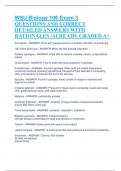
-
WSU Biology 106 Exam 3 QUESTIONS AND CORRECT DETAILED ANSWERS WITH RATIONALES |ALREADY GRADED A+
- Exam (elaborations) • 14 pages • 2023
- Available in package deal
-
- $11.99
- + learn more
WSU Biology 106 Exam 3 QUESTIONS AND CORRECT DETAILED ANSWERS WITH RATIONALES |ALREADY GRADED A+ Arthropods - ANSWER- Phyla with greatest amount of diversity with 85% of animal spp 700 million years ago - ANSWER- When the first animals originated Porifera (sponges) - ANSWER- Phyla with no tissues, muscles, nerves, or specialized organs Choanocytes - ANSWER- Flow of water and food acquisition in sponges Amoebocytes - ANSWER- Found in sponges, these cells are mobile and perform numer...
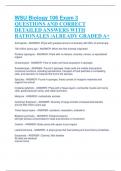
-
WSU Biology 106 Exam 3 QUESTIONS AND CORRECT DETAILED ANSWERS WITH RATIONALES |ALREADY GRADED A+
- Exam (elaborations) • 14 pages • 2023
- Available in package deal
-
- $13.99
- + learn more
WSU Biology 106 Exam 3 QUESTIONS AND CORRECT DETAILED ANSWERS WITH RATIONALES |ALREADY GRADED A+ Arthropods - ANSWER- Phyla with greatest amount of diversity with 85% of animal spp 700 million years ago - ANSWER- When the first animals originated Porifera (sponges) - ANSWER- Phyla with no tissues, muscles, nerves, or specialized organs Choanocytes - ANSWER- Flow of water and food acquisition in sponges Amoebocytes - ANSWER- Found in sponges, these cells are mobile and perform numer...
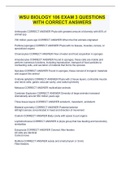
-
WSU BIOLOGY 106 EXAM 3 QUESTIONS WITH CORRECT ANSWERS
- Exam (elaborations) • 15 pages • 2023
-
- $9.99
- + learn more
Arthropods CORRECT ANSWER Phyla with greatest amount of diversity with 85% of animal spp 700 million years ago CORRECT ANSWER When the first animals originated Porifera (sponges) CORRECT ANSWER Phyla with no tissues, muscles, nerves, or specialized organs Choanocytes CORRECT ANSWER Flow of water and food acquisition in sponges Amoebocytes CORRECT ANSWER Found in sponges, these cells are mobile and perform numerous functions, including reproduction, transport of food particles to nonf...
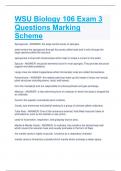
-
WSU Biology 106 Exam 3 Questions Marking Scheme
- Exam (elaborations) • 18 pages • 2024
- Available in package deal
-
- $12.99
- + learn more
WSU Biology 106 Exam 3 Questions Marking Scheme Spongocoel - ANSWER- the large central cavity of sponges. water enters the spongocoel through tiny pores called ostia and it exits through the large opening called the osculum. spongocoel is lined with choanocytes which help to create a current in the water. Spicule - ANSWER- structural elements found in most sponges. They provide structural support and deter predators. Large ones are called megascleres while microscopic ones are calle...
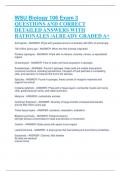
-
WSU Biology 106 Exam 3 QUESTIONS AND CORRECT DETAILED ANSWERS WITH RATIONALES |ALREADY GRADED A+
- Exam (elaborations) • 14 pages • 2024
- Available in package deal
-
- $12.99
- + learn more
WSU Biology 106 Exam 3 QUESTIONS AND CORRECT DETAILED ANSWERS WITH RATIONALES |ALREADY GRADED A+ Arthropods - ANSWER- Phyla with greatest amount of diversity with 85% of animal spp 700 million years ago - ANSWER- When the first animals originated Porifera (sponges) - ANSWER- Phyla with no tissues, muscles, nerves, or specialized organs Choanocytes - ANSWER- Flow of water and food acquisition in sponges Amoebocytes - ANSWER- Found in sponges, these cells are mobile and perform numer...
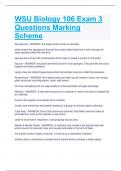
-
WSU Biology 106 Exam 3 Questions Marking Scheme
- Exam (elaborations) • 18 pages • 2024
- Available in package deal
-
- $11.99
- + learn more
WSU Biology 106 Exam 3 Questions Marking Scheme Spongocoel - ANSWER- the large central cavity of sponges. water enters the spongocoel through tiny pores called ostia and it exits through the large opening called the osculum. spongocoel is lined with choanocytes which help to create a current in the water. Spicule - ANSWER- structural elements found in most sponges. They provide structural support and deter predators. Large ones are called megascleres while microscopic ones are called mi...
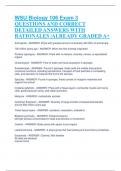
-
WSU Biology 106 Exam 3 QUESTIONS AND CORRECT DETAILED ANSWERS WITH RATIONALES |ALREADY GRADED A+
- Exam (elaborations) • 14 pages • 2023
- Available in package deal
-
- $12.99
- + learn more
WSU Biology 106 Exam 3 QUESTIONS AND CORRECT DETAILED ANSWERS WITH RATIONALES |ALREADY GRADED A+ Arthropods - ANSWER- Phyla with greatest amount of diversity with 85% of animal spp 700 million years ago - ANSWER- When the first animals originated Porifera (sponges) - ANSWER- Phyla with no tissues, muscles, nerves, or specialized organs Choanocytes - ANSWER- Flow of water and food acquisition in sponges Amoebocytes - ANSWER- Found in sponges, these cells are mobile and perform numerou...
goood luck
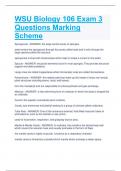
-
WSU Biology 106 Exam 3 Questions Marking Scheme
- Exam (elaborations) • 18 pages • 2023
- Available in package deal
-
- $13.09
- + learn more
WSU Biology 106 Exam 3 Questions Marking Scheme Spongocoel - ANSWER- the large central cavity of sponges. water enters the spongocoel through tiny pores called ostia and it exits through the large opening called the osculum. spongocoel is lined with choanocytes which help to create a current in the water. Spicule - ANSWER- structural elements found in most sponges. They provide structural support and deter predators. Large ones are called megascleres while microscopic ones are called ...

-
Package deal for WSU Bio 106 Exam 1 Questions With 100% Correct Answers 2023
- Package deal • 18 items • 2023
-
- $47.99
- + learn more
WSU Bio 106 Exam 1 Questions With 100% Correct Answers 2023 WSU Bio 106 Exam 3 With 100% Correct Answers 2023 WSU Biology 106 Exam 2 With 100% Correct Answers 2023 WSU BIO 106 FINAL EXAM WITH 100% CORRECT ANSWERS 2023 WSU Bio 106 Carloye Exam #4 With 100% Correct Answers 2023 WSU Biology 106 Exam 1 With 100% Correct Answers 2023 WSU Bio 106 Exam 1

Do you wonder why so many students wear nice clothes, have money to spare and enjoy tons of free time? Well, they sell on Stuvia! Imagine your study notes being downloaded a dozen times for $15 each. Every. Single. Day. Discover all about earning on Stuvia



